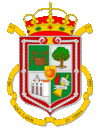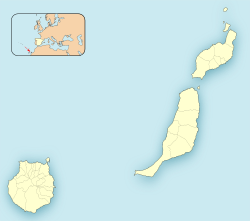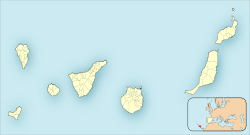Valleseco facts for kids
Quick facts for kids
Valleseco
|
|||
|---|---|---|---|
|
|||

Municipal location in Gran Canaria
|
|||
| Country | Spain | ||
| Autonomous Region | Canary Islands | ||
| Province | Las Palmas | ||
| Island | Gran Canaria | ||
| Area | |||
| • Total | 22.11 km2 (8.54 sq mi) | ||
| Population
(2018)
|
|||
| • Total | 3,784 | ||
| • Density | 171.14/km2 (443.26/sq mi) | ||
| Time zone | UTC+0 (GMT) | ||
Valleseco is a town and a municipality. It is located in the Las Palmas province. You can find it on Gran Canaria, one of the Canary Islands. Valleseco is in the north-central part of Gran Canaria. Its name means "dry valley" in Spanish. But it's actually one of the wettest places on the island! In 2018, about 3,784 people lived there. The town covers an area of 22.11 square kilometers. It sits high up, about 1,000 meters above sea level.
Valleseco town is about 3 kilometers southwest of Teror. It is also 17 kilometers southwest of Las Palmas city. The area has deep valleys and ravines. It is also very rich in plants. More than 80% of its land is protected as Nature Reserves.
Valleseco is 1,000 meters above sea level. It often looks like it is covered in a "sea of clouds". This helps make the landscape very green and lush. Here, the trade winds bring rain. Locals say the rain "seems not to wet but soak." This rain is very important for farmers. It helps them grow potatoes, corn, and fruits.
Contents
Exploring Valleseco: Places to Visit
The Town Center: Heart of Valleseco
The most famous building in Valleseco is the Saint Vicente Ferrer's Temple. It is a simple church, but it is the oldest building in Valleseco, built in 1898. Inside, you can see a special pulpit and a wooden ceiling. These are made in the Mudejar style, which is a mix of Christian and Islamic art.
The church also has old statues that came from an even older chapel. There is a special container holding a piece of the saint's arm bone. The most important treasure is a German organ from the 1700s. It came from another church and has been fixed up recently.
Nearby, you can find the Cornmeal Mill. It was built over 80 years ago. Two large spinning stones grind corn here. They make "gofio," which is a type of toasted cornmeal.
The Tourist Information Office is also in the town center. It has an exhibition of local crafts. You can see things like woven fabrics, musical instruments, and wooden furniture. There are also traditional Canarian costumes and special openwork lace. These items are all made by local artists.
Barranco de la Virgen: A Green Valley
The Barranco de la Virgen is one of the two main ravines in Valleseco. It is surrounded by tall mountains. Here, you can truly enjoy the sound of silence.
This ravine is part of the Doramas Rural Park. It is home to a special type of forest called laurisilva. This kind of forest used to cover most of the island's inside. One part of this ravine, Barranco Oscuro, is very important. It is a Total Nature Reserve, which means it has the highest protection in the Canary Islands. It runs between high cliffs. These cliffs have protected unique plants that are found only here.
Because of its rich water and good land, farming grew quickly here. Many old, grand buildings and farms were built. You can still see them along the ravine today. You can also find traces of old mills. These show how important water was to the area's past.
La Laguna: A Volcanic Lake
About 2.5 kilometers from the town center, you will find La Laguna de Valleseco. You can get there from the roads to Teror (GC-21) and Firgas (GC-30).
La Laguna is a recreational area in the Doramas Rural Park. It was formed inside a volcanic crater. The crater is now filled with laurisilva forest. You can walk around La Laguna to see the different trees in this unique forest. It is a small lake where many birds come to drink. You might see small birds like canaries, or even migratory birds like herons.
The Summit: High Up in the Mountains
If you follow the GC-21 road up the mountain, you will enter the Protected Landscape of the Peaks Nature Reserve. This area is very important for collecting water on the island. Many special plants grow here, especially the Canarian pine tree.
Above an area called Lanzarote, there is another nature reserve. It is called Cortijo de Calderetas. You can reach it by walking a short path from the road. This area has a long history, going back to when the island was first explored. Other old farms like Cueva Corcho and Crespo are also found nearby. This area has large pine and chestnut forests. These trees were planted where there used to be empty land. On a clear day, you can sometimes see the city of Las Palmas far away.
The Montañón Negro, or "Big Black Mountain," is on the edge of the municipality. Its rough and dry landscape shows that it was formed by a volcano not long ago. Because of its unique rocks, it has been named a natural monument. It is now part of the Canary Islands Nature Reserve Network.
Delicious Food: Valleseco's Gastronomy
Valleseco offers many tasty dishes. Most of them are made with meat. You can find pork, goat, beef, or rabbit. These meats are often marinated, stewed, or served with sauce. Some special dishes include:
- "Mojo de cochino": Pork with a special Canarian sauce.
- Kid goat in sauce.
- Marinated pork and rabbit.
- Beef stew.
- Roasted pork leg.
Other popular dishes are:
- Vegetable stew with "jaramagos": These are wild greens picked from the countryside.
- Watercress stew: Made with watercress grown in special areas.
- Coriander soup: Served with kneaded toasted cornmeal and goat cheese.
Fun Times: Festivals in Valleseco
The main festivals in Valleseco honor Saint Vicente Ferrer. They usually happen in mid-May or early June. The exact date depends on when Easter is.
Another big celebration takes place on the first Sunday of October. This festival honors Nuestra Señora de la Encarnación. It is also the Apple Festival! On the day before the main celebration, people dress in traditional costumes.
See also
 In Spanish: Valleseco para niños
In Spanish: Valleseco para niños






